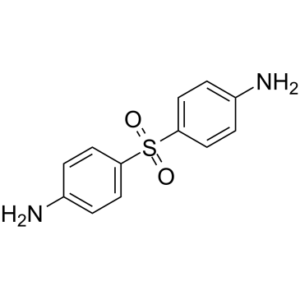This product is for research use only, not for human use. We do not sell to patients.

| Size | Price | Stock |
|---|---|---|
| 100g | $350 | Check With Us |
| 200g | $550 | Check With Us |
| 500mg | $925 | Check With Us |
Cat #: V5192 CAS #: 80-08-0 Purity ≥ 98%
Description: Dapsone (Diaphenylsulfone; Sulfona) is a synthetic derivative of diamino-sulfone which is active against a wide range of bacteria but mainly employed for its actions against mycobacterium leprae.
References: Y I Zhu, et al. Dapsone and sulfones in dermatology: overview and update. J Am Acad Dermatol
Publications Citing InvivoChem Products
Product Promise

- Physicochemical and Storage Information
- Protocol
- Related Biological Data
- Stock Solution Preparation
- Quality Control Documentation
| Molecular Weight (MW) | 248.30 |
|---|---|
| Molecular Formula | C12H12N2O2S |
| CAS No. | 80-08-0 |
| Storage | -20℃ for 3 years in powder formr |
| -80℃ for 2 years in solvent | |
| SMILES Code | C1=CC(=CC=C1N)S(=O)(=O)C2=CC=C(C=C2)N |
| Synonyms | 4,4'-Diaminodiphenyl sulfone; Sulfona; Diaphenylsulfone; 4,4'-Sulfonyldianiline; |
| Protocol | In Vitro | Dapsone are added to cell lysates (100 μg of protein) and DHPS activity assay is tested. Dapsone exhibits an IC50 of 3.0 μg/ml for E. coli C600 in DHPS activity assay, but the growth of E. coli C600 is not inhibited at 256 μg/ml Dapsone. For the recombinant strain carrying M. leprae folP1 (pML101), Dapsone shows an IC50 of 0.06 μg/ml and a MIC of 1 μg/ml. |
|---|---|---|
| In Vivo | In L. major-infected BALB/c MiceDapsone (topical treatment; 50 mg/kg; twice daily; 30 days) leads to sizes lesions around 186 mm2 compared to 125 mm2 for control mice. Furthermore, the amount of DAP quantified in the lesions treated with DAP cream is 9.6±8.5 µg of DAP/mg of skin. However, the number of parasites found in the spleen is significantly lower in mice treated with the cream than in non-treated mice. |
| Solvent volume to be added | Mass (the weight of a compound) | |||
|---|---|---|---|---|
| Mother liquor concentration | 1mg | 5mg | 10mg | 20mg |
| 1mM | 4.0274 mL | 20.1369 mL | 40.2739 mL | 80.5477 mL |
| 5mM | 0.8055 mL | 4.0274 mL | 8.0548 mL | 16.1095 mL |
| 10mM | 0.4027 mL | 2.0137 mL | 4.0274 mL | 8.0548 mL |
| 20mM | 0.2014 mL | 1.0068 mL | 2.0137 mL | 4.0274 mL |
This equation is commonly abbreviated as: C1 V1 = C2 V2
- (1) Please be sure that the solution is clear before the addition of next solvent. Dissolution methods like vortex, ultrasound or warming and heat may be used to aid dissolving.
- (2) Be sure to add the solvent(s) in order.




































